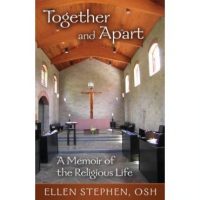
Author: Chris Roth
Published in Communities Magazine Issue #146
Together and Apart: A Memoir of the Religious Life
By Ellen Stephen, OSH
Morehouse Publishing, Harrisburg, New York, 2008; Paperback, 148 pages
If you’re a secular communitarian, you may assume that a book about living in a convent will have little or nothing to do with you. Together and Apart will almost certainly cause you to uncloister your thought habits in this area.
Ellen Stephen writes with more wisdom, insight, and candor about residential intentional community than most authors I’ve read. This is partly because she herself has spent more than four decades immersed in it; she is also a gifted writer and seasoned observer of herself and of human nature. While I have never been a member of a religious community (monastery, convent, ashram, etc.), many of her stories about her life in the Order of Saint Helena (in several different convents) resonated with what I’ve experienced and witnessed in secular communities. In her memoir, the life of a monastic and the life of a secular communitarian—including the issues that confront each—do not emerge appearing so different after all. In fact, they are in some respects almost identical.
While a popular conception is that religious communities tend to be hierarchical and dogmatic—and therefore perhaps different from more egalitarian secular communities—these do not appear to be the dominant themes in Ellen’s life in an Episcopalian community. In Ellen’s group (once nominally answerable to a monastery, but now independent of any male authority), sisters rotate through roles, share power, and actively question both theology and day-to-day guidelines they set for themselves. She describes her order’s “bad old days” when she first took her vows, during which fear and subservience to the superior ruled too often, and its subsequent evolution over the decades into a far more egalitarian, mutually supportive, mutually empowering paradigm emphasizing connection. “A call to the religious life is first and foremost an invitation to be together,” she writes. “There is always a consciousness of the importance of human relationship, of love.”
The sisters are committed not only to each other but to a path that respects the earth. Although Ellen’s community is not explicitly ecological in its focus, its commitment to “poverty” (understood as simplicity and sharing) and social justice mean that it may actually be more ecological and sustainable in its practices than the majority of secular communities. The sisters wear mostly used clothing, not only because they need to operate within a very low budget but because “using what others no longer need seems like a kind of recycling, and recycling in all its forms is an important aspect of poverty today, as well as a witness against consumerism and waste.” The amenities in their daily lives are simple and shared, as the sisters seek alternatives to the excess, exploitation, and economic disparity that they see in a society of individualistic materialism and ownership.
This approach is not always easy. “Sharing a kitchen or any other space with other people,” she remarks wryly, “can be a real challenge to serenity and sisterly or brotherly love.” In fact, even deciding on décor in a convent can pose difficulties, now that the traditionally austere guidelines have loosened up a bit: “‘Homey’ to one sister may mean frilly white curtains and flowered throw pillows. That doesn’t signify home to me.”
But perhaps the biggest challenges come from simply learning to live together as individuals with differing personalities, priorities, needs, and personal issues. Ellen repeatedly disabuses readers of any rose-colored glasses through which they may wish to look at community living, while also explaining why she has found the challenges worth confronting. Her descriptions and perspectives are, if anything, on the “dark” side, but they are meant to counteract false images. If she doesn’t speak for you in these passages, she likely speaks for someone with whom you have lived:
“[Sometimes] the hardest thing for me in community is respecting another sister who does not seem to me to be choosing the ‘road less traveled,’” she writes. “It has taken slow-growing knowledge and acceptance of my own failings to begin to see beyond the faults of my sisters to the true self within that is to be accepted and loved.” At another point, she observes pithily, “We human beings are complex creatures, and complexity is hard to live with.”
The solution, she has found, is not to bottle up the difficulties, but instead to say what needs to be said to community mates, if it truly needs to be said (or to process it internally, if reflection shows that to be the best course). “Repressed feelings are like toothpaste in a tube—under enough stress a capped tube will crack open and the paste will ooze out at an inappropriate point. On the other hand, freely choosing to bear a difficult thing may be a gift of love.”
She gives her perspective on the supposed “holiness” of religious communities with characteristic candor: “Someone once said of the cloister that it does not automatically ensure holiness: a wall may enclose a lovely secret garden, or a stinking rubbish heap.” Elsewhere, she writes, “When our order was in the early stages of self-study and renewal, our superior said in jest that she was going to write a book about the life called The Grunge and the Glory. Living a life that is both culturally apart and intensely together is exacting. There is a lot of grunge.”
This book contains many more gems: thoughtful observations on the balance of work, relationships, and one’s own inner life in community (and how different individuals’ approach to that balance can itself create tensions); the importance of having well-designed, protracted processes for incorporating new members, as well as graceful, deliberate ways to deal with a member’s separation or exit from the community; reflections on the challenges faced by founders and elders witnessing change within their own communities; and some simple, sage one-liners: “Some of the stress that arises in community life comes from insecurity trying to clothe itself as power.” “Even the most desired outcome is much better chosen than imposed.”
While describing “fair and efficient leadership, whether designated or undesignated” as the “‘oil’ that keeps the ‘machinery’ of relationships and daily life moving along smoothly,” Ellen sees the ideal form of that leadership as “almost invisible”—not ostentatious or concentrated, but flowing through different people in different circumstances. Ellen’s houses function with no one sister in charge, but with delegated responsibilities, and with whole-group decisions made in weekly house meetings, by consensus when possible. These meetings start with a few moments of silence, then the setting of an intention, then personal “check-ins.” (Does this sound familiar to anyone in community?)
A few final notes: if you don’t resonate well with the word “God” as a descriptor of ultimate reality and the source of one’s guidance, you may want to substitute “Gaia,” “the Universe,” “our essential being,” or some other term throughout this book. If you are averse to the idea that we are part of something larger than ourselves—“family members” with responsibilities as well as opportunities—or believe that everything is meaningless, disordered chaos, or think that monastics and “seekers” of every kind take things way too seriously, you may not like this book (or, on the other hand, you might take perverse pleasure in it). Otherwise, I can almost guarantee that this very personal story of hearing and answering the call to community living has much to teach even the most secular communitarian.
Eden Within Eden: Oregon’s Utopian Heritage
By James J. Kopp
Oregon State University Press, Corvallis, 2009; Paperback, 370 pages
If Together and Apart portays community life with an intensely personal and particular focus, Eden Within Eden takes the opposite tack. In it, historian and librarian James Kopp assembles an encyclopedic look at the utopian history of a single state. (While “utopian” and “communal” are not strictly equivalent terms, for the purposes of this review they are interchangeable.)
Since the middle of the 19th century, Oregon has been home to nearly 300 known communal experiments, in addition to countless others not describing or advertising themselves as such. Most of us living in community have only a limited grasp of or perspective on what preceded us. As someone involved in several of Oregon’s recent “utopian experiments” starting in 1986, I had probably an above-average amount of knowledge on the subject—and yet most of the groups described in this book, except the contemporary ones, were unknown to me.
Like Together and Apart, Eden Within Eden describes both the “grunge” and the “glory” of community living—utopian experiments that were deeply dysfunctional, and others that were by most measurements wildly successful in improving people’s lives and achieving their cooperative goals. Almost always, it’s a mixed bag, with different folks choosing different strokes, learning, growing, giving, and receiving through the process. These groups contribute in both subtle and obvious ways to the larger society, often for good, occasionally for ill (as with the almost-forgotten Holy Rollers and the less-forgotten experiment called Rajneeshpuram, where, amidst some “good works,” members also poisoned the local food supply and had other unsavory activities planned).
After introductory looks at Oregon as Eden and the American Utopian Tradition, Kopp writes extensively about the Aurora Colony, the settlers’ first communal experiment (and also one of the most successful, long-lasting ones), founded in 1856. After a slow period, intentional community start-ups experienced a resurgence in the 1880s and 1890s, and various cooperative ventures blossomed in the early 20th century before they were overtaken by larger historical events. The most recent resurgence, the one with which we’re all most familiar, started in the late 1960s and continues, in various forms, to this day. As most readers of this magazine know, the myth that the intentional community movement “died” in the early 1970s is anything but the truth, although many of the groups from that early boom did fold. Eden Within Eden reflects the richness of recent and contemporary communal activity within Oregon. Nearly half of this lengthy book is devoted to a resource guide to Oregon’s utopian heritage and to additional notes. Not surprisingly, Communities, which has been documenting contemporary intentional community projects since 1972, is the one source most frequently cited.
Too often communitarians may feel isolated in their attempts to create the structures and realities that will encourage more cooperative living. But both in contemporary times and historically, those engaged in similar experiments are far from alone, as you know if you are reading Communities. Books like Eden Within Eden can provide both encouragement and valuable lessons to contemporary communitarians. Every state deserves this kind of resource; and in the meantime, you don’t have to be an Oregonian to benefit from the perspective this book provides.





















